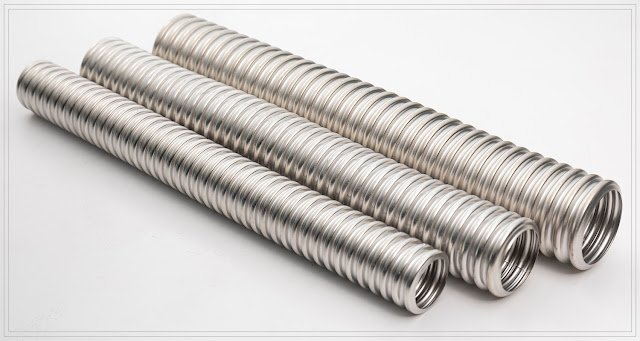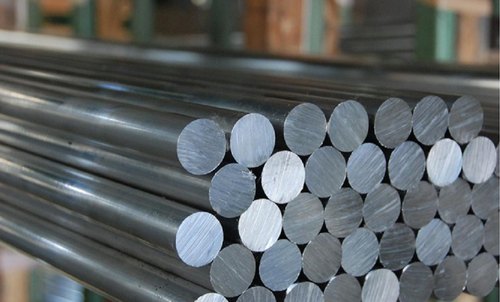Duplex stainless steel is a type of
stainless steel that is composed of grains of two types of
stainless steel material, austenitic and ferritic. The word
"duplex" refers to the two-phase microstructure of ferritic and austenitic steel grains. The ferritic and austenitic
stainless steel grades have approximately equal proportions (i.e., 50% each) in
duplex stainless steel.
Duplex stainless steel offers high mechanical strength and excellent corrosion resistance properties.
Philips Metal Explains Duplex Stainless Steel
Duplex stainless steel is considered an alternative to the expensive nickel alloys and high alloy austenitic stainless steel materials used in the most demanding applications.
Some benefits of duplex stainless steel include:
- Two times stronger than ferritic or austenitic stainless steel grades
- Higher toughness and ductility
- Shows very good resistance from stress corrosion cracking
- Cheaper than the austenitic stainless steel material because the nickel and
molybdenum alloy content is less in duplex stainless steel than austenitic
stainless steel
The properties of duplex stainless steel
The microstructure of duplex stainless steels features both the crystallographic structures of approximately 50% ferrite (a body-centred cubic structure) and 50% austenite (a face-centred cubic structure). Both of these phases co-exist as a stable mixture, unlike two-phase alloys, where one of the two phases manifests as precipitates. The alloying elements in duplex stainless steels are either ferritisers (e.g. chromium, silicon, molybdenum) or austenitisers (e.g. carbon, nickel, nitrogen), which means they favour the formation of the ferritic and austenitic phases, respectively.
At high temperatures, the relatively unstable ferrite phase in duplex steels gets converted into the undesirable α’ (alpha prime) phase, which causes a decrease in their mechanical properties, such as strength and toughness, and also in their corrosion resistance. This phenomenon is called embrittlement [1]. The worst temperature at which embrittlement occurs is at 475 oC; however, the production of the alpha prime phase may start to occur at temperatures as low as 300 oC, and this limits the maximum service temperature of duplex steels.
Typical duplex stainless steels show a higher yield strength than typical martensitic, austenitic and ferritic grades. However, they have a narrow range of working temperatures due to the precipitation of intermetallic phases that starts to occur above 300 oC and the onset of brittleness as they approach cryogenic temperatures . The table below presents selected properties of some common grades of duplex stainless steels.
Duplex stainless steel applications
Due to the limitations of duplex stainless steels such as poor formability and machinability, in addition to their highly complicated metallurgical process of production compared to ferritic, austenitic and martensitic stainless steels, duplex steels are used mostly for niche applications.
Applications of duplex stainless steels take into account their limitations and advantages, but the major applications require corrosion resistance, such as pitting and crevice corrosion resistance, stress corrosion resistance, fatigue corrosion, abrasion corrosion or resistance to corrosive environments that are acidic or caustic. Some of the common industrial applications are outlined below
Paper production
Duplex stainless steels are preferred to austenitic and ferritic stainless steels for the fabrication of vessels that contain bleach and other corrosive liquids in paper processing.
Desalination
Desalination of seawater, a process that presents highly corrosive chlorine in a high-temperature environment, is a sturdy test for a corrosion-resistant material. Duplex stainless steels have become the material of choice for the fabrication of evaporators. They can also be made with thinner cross-sections because of the higher strength and corrosion resistance of duplex stainless steels.
Oil and Gas
The development of duplex stainless steels with PRE numbers above 40 has made it possible to manufacture components such as pumps, piping and manifolds that require high resistance to pitting and crevice corrosion, which are crucial in the oil and gas industry.
Construction
Duplex stainless steels are used in the construction of load-bearing members that also require corrosion resistance. Typical applications include the construction of bridges over seawater or structures that are in close proximity to the sea.
Food and Drink Storage
Lean duplex steels show promise in the commercial storage of food and drinks during processing due to their relatively low cost while retaining excellent corrosion resistance and strength.
Benefits of Duplex Stainless Steel
While duplex stainless steel only comprises a small percentage of the global stainless steel market, it has a range of benefits when compared to traditional austenitic stainless steel and ferritic stainless steel grades.
Improved Strength
Many duplex grades are as much as two-times stronger than austenitic and ferritic stainless steel grades.
High Toughness and Ductility
Duplex stainless steel is often more formable under pressure than ferritic grades and provides greater toughness. Though they often offer lower values than austenitic steels, the unique structure and characteristics of duplex steel often outweigh any concerns.
High Corrosion Resistance
Depending on the grade in question, duplex stainless steels offer comparable (or better) corrosion resistance as common austenitic grades. For alloys with increased nitrogen, molybdenum, and chromium, steels exhibit high resistance to both crevice corrosion and chloride pitting.
Cost Effectiveness
Duplex stainless steel offers all of the above benefits while requiring lower levels of molybdenum and nickel. This means that it is a lower-cost option than many traditional austenitic grades of stainless steel.The price of duplex alloys is often less volatile than other steel grades making it easier to estimate costs -- both at an upfront and lifetime level.The higher strength and corrosion resistance also means that many parts made using duplex stainless can be thinner than their austenitic counterparts providing lower costs.
Future trends of duplex stainless steel
New grades of duplex stainless steels are still being developed till date. The main driver of this endeavour is to further increase pitting corrosion resistance and this is achieved mainly by increasing key alloying elements such as chromium, molybdenum and nitrogen. The advantages of these increased alloying elements also come with disadvantages, mainly the destabilization of the ferrite phase, leading to unwanted precipitates. The challenge is to strike a balance between desirable properties mainly led by increased pitting corrosion resistance while limiting the production of undesirable intermetallic phases such as Cr2N by very precise heat treatment. A duplex steel grade, SAF 2707 HD, a 27Cr-7Ni-5Mo-0.4N with PRE-number of almost 50 has been developed, which is promising for the future of duplex steels in general




Comments
Post a Comment